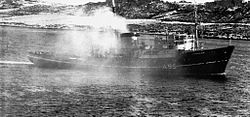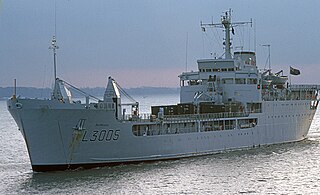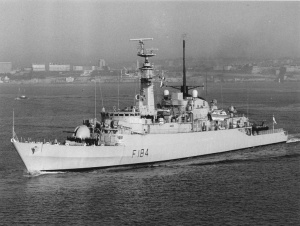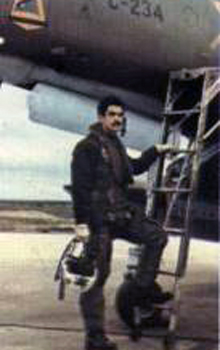Royal Navy


- Command
In Northwood, London: [2]
- Commander-in-Chief, Fleet: Admiral Sir J.D.E. Fieldhouse
- Commander Task Group 324.3 and Flag Officer Submarines: Vice-Admiral P.G.M. Herbert
In the South Atlantic:
- Commander Task Group 317.8 (Carrier/Battle Group) and Flag Officer, First Flotilla: Rear-Admiral J.F. Woodward (HMS Hermes)
- Commander Task Group 317.0 (Amphibious Task Group) and Commodore Amphibious Warfare: Commodore M.C. Clapp (HMS Fearless)
- Centaur-class aircraft carrier - V/STOL carrier
- HMS Hermes - Flagship Task Group 317.8 (†3)2 SHAR pilots
- Captain L.E. Middleton
- 800 Naval Air Squadron (12 BAE Sea Harriers, including 7 absorbed from 899 training squadron and trials)
- Lt Commander A.D. Auld
- part 809 Naval Air Squadron (4 BAE Sea Harriers absorbed into 800 Squadron)
- part No. 1 Squadron RAF (8 Hawker Siddeley Harrier GR.3)
- 825 Naval Air Squadron (4 Sea Kings HAS.2; formed from 706 training sqn) [3]
- 826 Naval Air Squadron (12 Sea King HAS.5) [3]
- Lt Commander D.J.S. Squier
- 846 Naval Air Squadron (6 Sea King HC.4) [3]

- Invincible-class aircraft carriers
- HMS Invincible (†3)2 SHAR pilots
- Captain J.J. Black RN
- 801 Naval Air Squadron (8 BAE Sea Harriers including 5 absorbed from 899 training squadron))
- Lt Commander N.D. Ward
- part 809 Naval Air Squadron (4 BAE Sea Harriers absorbed into 801 Squadron))
- 820 Naval Air Squadron (10 Sea King HAS.5) [3]
- Lt Commander R.J.S. Wykes-Sneyd
- Landing platform docks

- HMS Fearless - Flagship Task Group 317.0 (†6)
- Captain E.S.J. Larken
- 4 LCU (Foxtrot One to Four), 100 troops or one Main Battle Tank. LCU Foxtrot Four, bombed and sunk in the Choiseul Sound by A-4B Skyhawks
- 4 LCVP (Foxtrot Five to Eight), 25 troops or a Land Rover with trailer.
- flight deck for 4 Sea King HC.4 (not embarked)

- HMS Intrepid
- Captain P.G.V. Dingemans
- 4 LCU (Tango One to Four)
- 4 LCVP (Tango Five to Eight)
- flight deck for 4 Sea King HC.4 (not embarked)

- Type 82 destroyer
- HMS Bristol
- Captain A. Grose
- Type 42 destroyers
- HMS Sheffield - set on fire by an Aérospatiale AM39 Exocet (Air-to-Surface) Anti-ship missile launched from a Dassault Super Étendard 4 May, (†20) - Fatal Damage (sank on 10 May)
- Captain J.F.T.G. Salt
- HMS Coventry - sunk on 25 May by three bombs from a Douglas A-4B Skyhawk (†19+1) - Fatal Damage
- Captain D. Hart Dyke
- HMS Glasgow - hit by unexploded bomb from a Douglas A-4B Skyhawk 12 May, withdrawn from war - Moderate Damage
- Captain A.P. Hoddinott
- HMS Cardiff
- Captain M.G.T. Harris
- HMS Exeter
- Captain H.M. Balfour
- County-class destroyers
- HMS Glamorgan - hit by an Aérospatiale MM38 Exocet (surface-to-surface) anti-ship missile on 12 June (†14) - Major Damage
- Captain M.E. Barrow
- HMS Antrim - hit by unexploded bomb from an IAI Dagger - Major Damage
- Captain B.G. Young
- Type 22 frigates
- HMS Brilliant - hit by IAI Dagger cannon fire - Minor Damage
- Captain J.F. Coward
- HMS Broadsword - hit by IAI Dagger cannon fire, later damaged by bomb from Douglas A-4B Skyhawk - Moderate Damage
- Captain W.R. Canning
- Type 21 frigates

- HMS Active
- Commander P.C.B. Canter
- HMS Alacrity - sank Argentine transport ship ARA Isla de los Estados. Slightly damaged by bomb. Lynx helicopter damaged by return fire from armed coaster ARA Monsunen.
- Commander C.J.S. Craig
- HMS Antelope - sank 24 May due to unsuccessful defusing attempt of unexploded bombs from Douglas A-4B Skyhawks (†2) - Fatal Damage
- Commander N.J. Tobin
- HMS Ardent - sank 21 May by bombs from IAI Daggers and Douglas A-4Q Skyhawks (†22) - Fatal Damage
- Commander A.W.J. West
- HMS Ambuscade
- Commander P.J. Mosse
- HMS Avenger
- Captain H.M. White
- HMS Arrow - hit by IAI Dagger cannon fire - Minor Damage
- Commander P.J. Bootherstone
- Leander-class frigates
- HMS Andromeda
- Captain J.L. Weatherall
- HMS Argonaut - hit by Aermacchi MB.339A cannon/rocket and unexploded bombs from Douglas A-4B Skyhawks (†2) - Major Damage [4]
- Captain C.H. Layman
- HMS Minerva
- Commander S.H.G. Johnston
- HMS Penelope
- Commander P.V. Rickard
- Rothesay-class frigates
- HMS Yarmouth
- Commander A.S. Morton
- HMS Plymouth - unexploded bombs from IAI Daggers - Major Damage
- Captain D. Pentreath
- HMS Rhyl - Ascension Island Guardship

- Ice patrol ship
- HMS Endurance
- Captain N.J. Barker
- Castle-class patrol vessels
As despatch vessels, carrying mail between the Task Force and Ascension Island.
- HMS Leeds Castle
- Lt Commander C.F.B. Hamilton
- HMS Dumbarton Castle
- Lt Commander N.D. Wood

- Churchill-class submarines
- HMS Conqueror - sank ARA General Belgrano
- HMS Courageous
- Commander R.T.N. Best
- Oberon-class submarines
- HMS Onyx - ran aground - Moderate Damage
- Lieutenant-Commander A. O. Johnson
- Valiant-class submarines
- HMS Valiant - Argentine fighters returning from an aborted mission jettisoned bombs nearby - Minor Damage [5]
- Commander T.M. Le Marchand
- Swiftsure-class submarines
- HMS Spartan
- Commander J.B. Taylor
- HMS Splendid
- Commander R.C. Lane-Nott
- Hecla-class survey vessels
2,744 t, used as casualty ferries (hospital ships)
- HMS Hecla
- Captain G.L. Hope
- HMS Herald
- Commander R.I.C. Halliday
- HMS Hydra
- Commander R.J. Campbell
- Trawler/Minesweepers - Minesweeper Auxiliary (MSA) 11th MCM Squadron

Civilian trawlers converted to Extra-Deep Armed Team Sweep (EDATS) with some extempore acoustic and sonar equipment. They were manned by Royal Naval personnel, mainly from 1st MCM Squadron based at Rosyth. All five minesweepers were involved in clearing two minefields off Port Stanley.
- HMS Cordella 1,238 GRT [6]
- Lieutenant-Commander M. Holloway
- HMS Farnella 1,207 GRT [6]
- Lieutenant R. Bishop
- HMS Junella 1,615 GRT [6]
- Lieutenant-Commander M. Rowledge
- HMS Northella 1,238 GRT [6]
- Lieutenant-Commander J. Greenop
- HMS Pict 1,478 GRT [6]
- Lieutenant-Commander D. Garwood
























